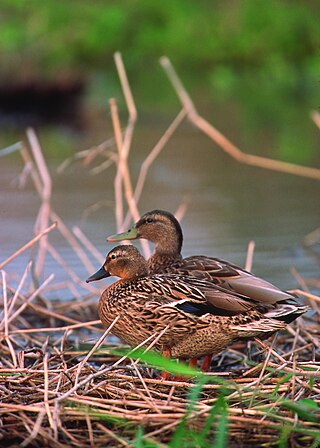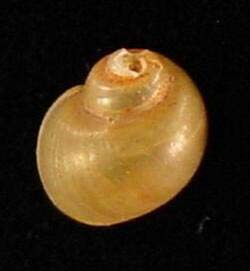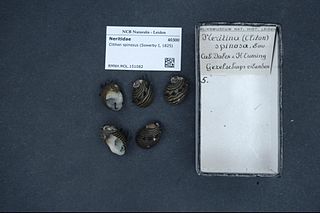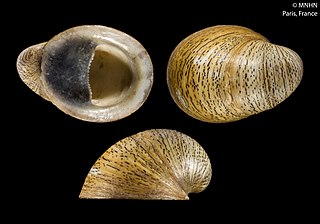
The Hawaiian duck or koloa is a species of bird in the family Anatidae that is endemic to the large islands of Hawaiʻi. Taxonomically, the koloa is closely allied with the mallard. It differs in that it is monochromatic and non-migratory. As with many duck species in the genus Anas, Hawaiian duck and mallards can interbreed and produce viable offspring, and the koloa has previously been considered an island subspecies of the mallard. However, all major authorities now consider this form to be a distinct species within the mallard complex. Recent analyses indicate that this is a distinct species that arose through ancient hybridization between mallard and the Laysan duck. The native Hawaiian name for this duck is koloa maoli, or simply koloa. This species is listed as endangered by the IUCN Red List of Threatened Species, and its population trend is decreasing.

The New Zealand mud snail is a species of very small freshwater snail with a gill and an operculum. This aquatic gastropod mollusk is in the family Tateidae.

Neritidae, common name the nerites, is a taxonomic family of small to medium-sized saltwater and freshwater snails which have a gill and a distinctive operculum. The family Neritidae includes marine genera such as Nerita, marine and freshwater genera such as Neritina, and freshwater and brackish water genera such as Theodoxus.

Sicyopterus stimpsoni, commonly known as the Nopoli rockclimbing goby, oopu nopili, or Stimpson's goby, is a species of amphidromous goby endemic to the U.S. state of Hawaii. This species can reach a length of 19.8 centimetres (7.8 in) SL.

Beddomeia hallae, also known as Buttons Rivulet hydrobiid snail, is a species of small freshwater snail that is endemic to Australia. The species is an aquatic operculate gastropod mollusk in the family Hydrobiidae. Beddomeia hallae belongs to the genus Beddomeia, which is the largest group in the family Hydrobiidae, consisting of 47 species. In the Threatened Species Protection Act 1995, this species is one of the 37 Beddomeia species listed as endangered, however, on the International Union for Conservation of Nature Red List, the species is listed as vulnerable. Found in Tasmania, in the streams of Buttons Rivulet and Castra Rivulet, Beddomeia hallae is sighted in its natural habitat amongst wood, leaves and under stones. Nonetheless, the Beddomeia species including Beddomeia hallae are geographically isolated, existing within restricted ranges.
Beddomeia waterhouseae, also known as Claytons Rivulet freshwater snail, is a species of freshwater snail in the family Tateidae. This species is endemic to northern Tasmania in Australia. The holotype specimen was found in a very small tributary of Little Clayton's Rivulet and is held at the Australian Museum. B. waterhouseae is small and as an adult has a shell measuring between 1.7 to 3.7 mm in length. The shell shape is ovate-conic to broadly conic and has a thin inner lip and no columellar bulge. This species feeds on algae and detritus on rocks. The female of the species lay single eggs in capsules made of sand grains and attached to the underside of rocks or wood. B. waterhouseae is considered vulnerable by the IUCN as it has a very small range and is sensitive to water quality and so may be threatened by disturbances of its habitat. Other threats include habitat loss. Conservation activities such as assessment of the aquatic ecosystem and vegetal surveys are being undertaken in an attempt to preserve this species.

Newcomb's snail is a species of air-breathing freshwater snail, a gastropod mollusk in the family Lymnaeidae. This species is endemic to Hawaii, in the United States. Its natural habitat is rivers. It is threatened by habitat loss.
Glyptophysa is a genus of medium-sized sinistral (left-handed) air-breathing freshwater snails, aquatic pulmonate gastropod mollusks in the family of Planorbidae.

Conus textile, the textile cone or the cloth of gold cone is a venomous species of sea snail, a marine gastropod mollusk in the family Conidae, the cone snails, cone shells or cones. Textile cone snails live mostly in the Indian Ocean, along the eastern coast of Africa and around Australia.

Gillia altilis, common name the Buffalo pebblesnail, is a species of freshwater snail, an aquatic gastropod mollusk with an operculum in the family Lithoglyphidae.

Vitta usnea is a species of freshwater snail with an operculum, an aquatic gastropod mollusk in the family Neritidae, the nerites.
Neritona granosa is a species of freshwater snail with an operculum, an aquatic gastropod mollusk in the family Neritidae, the nerites.

Scurria variabilis is a species of sea snail, a true limpet, a marine gastropod mollusk in the family Lottiidae, one of the families of true limpets.

Thiara is a genus of freshwater snails, aquatic gastropod mollusks in the subfamily Thiarinae of the family Thiaridae.

Clea nigricans is a species of freshwater snail with an operculum, an aquatic gastropod mollusk in the family Buccinidae, the true whelks, most of which are marine.

Clithon spinosum is a species of brackish water and freshwater snail with an operculum, a nerite. It is an aquatic gastropod mollusk in the family Neritidae, the nerites.

Neripteron cornucopia is a species of freshwater snail, an aquatic gastropod mollusk in the family Neritidae, the nerites.

Neripteron is a genus of brackish water and freshwater snails, an aquatic gastropod mollusks in the subfamily Neritininae of the family Neritidae, the nerites.

Neripteron auriculatum is a species of brackish water and freshwater snail, an aquatic gastropod mollusk in the family Neritidae, the nerites.














